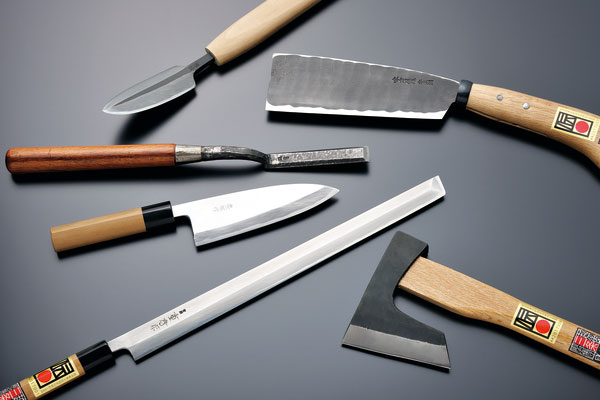 Photo:Niigata Prefecture
Photo:Niigata Prefecture
- Metal works
- Niigata
Echigo-sanjo cutlery Echigo sanjo uchihamono
High quality hand-forged blades
Made by traditional master craftsmen
Description
What is Echigo-sanjo cutlery ?
Echigo-Sanjo Uchihamono are hammer-forged blades produced in Sanjo City, Niigata prefecture. Unlike modern blades made using the stamp pressing and polishing techniques developed after the second world war, these blades are produced by hand-hammering using the traditional Japanese metal working techniques. Originally, farming tools were made, but nowadays, a broad range of cutting tools are produced, such as everyday kitchen knives and scissors, or hatchets and chisels. Echigo-Sanjo Uchihamono are distinguished by the high-standard of forge work in which red-hot metal is beaten and shaped. This forging technique enables easy shaping, and increases the blade’s strength by hammering out any space in the inner part of the metal, resulting in a high degree of strength and abrasion resistance. Some machinery may be used in the production process today, but the important processes that require highly-skilled work is carried out by hand to maintain the traditional high quality finish.
History
The history of Echigo-Sanjo Uchihamono dates back to the Edo period. Originally the techniques developed for making farming tools such as sickles and hoes. For two years from 1625, a local magistrate of the Sanjo Castle named Seibei OHYAMA invited nail craftsmen from Edo (current Tokyo) to teach the farmers how to make nails in order to lift them from poverty. Production of Japanese nails as a side job during the off-season increased, and some of the farmers became full-time blacksmiths. With this historical background, blacksmiths gathered around the current Sanjo City. There are documents that say there were already about twenty full-time blacksmiths in the castle town in 1661, and the forged blade industry in Sanjo is thought to have started around this time.
General Production Process
- 1. Forging and forge welding Forging is heating metal to a high temperature and then beating it to shape with a hammer or similar tool. By applying pressure, any space in the structure of the metal is eliminated and the strength of the metal increases. Blade making is a highly skilled craft; the color of metal changes by temperature from cherry red, orange, to white. The artisan indicates the temperature by the color, and takes the metal out of the furnace at the right timing for a particular task in the process. After heating at a temperature of about 900°C, the iron base and steel blade are first bonded using borax and iron oxide powder. For everyday kitchen knives, soft iron is used. Strong steel is used for blade edges; carbon tool steel (SK) or Yasuki steel are most commonly used.
- 2. Smith forging The heated metal is repeatedly hammered to bond the steel and soft iron, and then returned to the fire, followed by further beating and heating; this repetition removes impurities and the glowing surfaces are tightly pressure-bonded. This thorough hammering of the blade edge roughly shapes the knife and is an important process to ensure a strong blade.
- 3. Shaping After the steel and soft iron are firmly bonded, while the soft iron is still cherry red, the metal is manually cut into a beautiful knife shape. Every blade carefully cut and shaped by hand is a testament to the years of skill and practice of the craftsmen.
- 4. Quenching Polishing powder and baked soil are mixed with water and applied to the whole surface of the shaped metal. After drying, the blade is again heated in a furnace at a temperature of 780°C or so; the craftsman assesses the color of the metal and removes the blade to quench it by plunging into cold water.
- 5. Tempering The quenched blade has increased strength but is also brittle. To give it toughness and durability, it is tempered by being put it in a low-temperature furnace or oil at about 50 to 200°C and is left to cool.
- 6. Blade edging and removing warps Starting from a coarse whetstone, and gradually changing to a fine whetstone, the blade is ground to a sharp edge. A large amount of cooling water is used in the sharpening to prevent warps and irregularities, and to ensure even strength throughout the length of the blade.
Where to Buy & More Information
Sanjo Kaji Dojo
-
Address
-
Tel.+81-256-34-8080
-
ClosedMondays (open if Monday is holiday and closed the next day), December 29 to January 3
-
Business Hours9am to 5pm
-
Website
See more Metal works
- Nambu ironware
- Takaoka copperware
- Yamagata cast iron
- Sakai cutlery
- Tokyo silverware
- Echizen cutlery
- Osaka naniwa pewterware
- Tosa cutlery
- Tsubame-tsuiki copperware
- Shinshu Forged Blades
- Banshu-miki cutlery
- Higo inlays
- Echigo-sanjo cutlery
- Echigo-yoita cutlery
- Chiba Artisan Tools
- Tokyo antimony craft
See items made in Niigata
- Ojiya chijimi textiles
- Shiozawa tsumugi silk
- Hon-shiozawa silk
- Ojiya tsumugi silk
- Niigata lacquerware
- Kamo traditional chest
- Murakami carved lacquerware
- Tsubame-tsuiki copperware
- Echigo-sanjo cutlery
- Tokamachi traditional resist-dyed textiles
- Nagaoka Buddhist altar
- Tokamachi akashi chijimi textiles
- Echigo-yoita cutlery
- Sanjo Buddhist altar
- Niigata-shirone Buddhist altar































































































































































































































































































